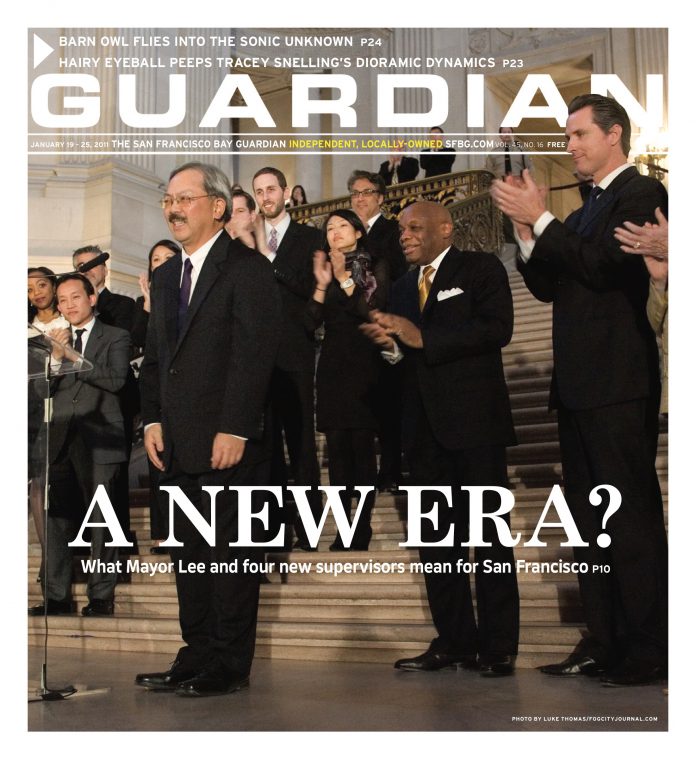arts@sfbg.com
HAIRY EYEBALL Walking through Tracey Snelling’s 10-year survey at Rena Bransten brings to mind the famous opening tracking shot of Orson Welles’ 1958 noir Touch of Evil. For over three tension-ratcheting minutes Welles’ camera — all swooping omniscience — takes in the garish sights and sounds of a tourist outpost along the U.S.-Mexico border as it tails an American car that, unbeknownst to the couple behind the wheel, has been planted with a bomb that’s about to go off.
Much like the back lot border-town surveyed by Welles, the Oakland-based Snelling pays repeated visits to liminal spaces: empty strip malls, dusty souvenir shops, seedy motels, and bygone roadside attractions. From her intricate miniature models of these buildings — many outfitted with ambient noise soundtracks, realistic interior lighting, looped video clips of “occupants,” and distressed paint jobs — to the mock-ups of the sort of neon signage once seen along Route 66 that greet you as soon as you walk into the gallery, Snelling’s art drops us somewhere south of some border, just on the edge of town, and definitely on the wrong side of the tracks.
The locations Snelling chooses are for the most part generic and yet deeply familiar. This is in no small part due to their recurrence as archetypical backdrops in pop culture and Hollywood films, something her art self consciously plays with. Take Big El Mirador, a large sculpture of an adobe hotel, for which Snelling has set up six DVD players behind the piece (coordinated with a sync box) to play a different film clip through each of the building’s six window to give the illusion of action happening in the rooms. Other models feature clips swiped from movies that feature similar structures, or are, as with the sculpture of Norma Desmond’s mansion from Sunset Boulevard, miniature versions of buildings from films.
At the same time, Snelling’s obsessive eye for detail — whether getting the fluorescent glare right inside a convenience store or building a perfectly weathered Tecate billboard — make each environment feel more “true-to-life,” inviting the viewer, much as a child does with a doll house, to construct narratives for the often-unseen occupants of these ghost town dioramas.
In other pieces Snelling situates the viewer as the occupant. In the space of a few steps one goes from looking at the exterior of model of the Motel El Diablo to standing in what could presumably be one of its rooms, complete with a cramped single bed, dresser, bad art on the wall, and more suggestively, a pair of black high heels casually tossed on the floor. Another life-size installation is a walk-through gift shop filled with to the brim with motion-activated tchotchkes, fake kachina dolls, Chinatown good luck dragons, and Hindu religious posters.
This scalar slip ‘n’ slide between life-sized and downsized only further adds to the fun house atmosphere generated by Snelling’s lovingly crafted and decidedly lonely monuments to displacement.
MARKING TIME
Max Cole’s acrylic-on-linen paintings feature alternating arrangements of two horizontal elements — ramrod straight lines of varying widths and small vertical hatch-marks — executed in varying shades of gray, black, brown, and white.
Like the painter Agnes Martin, Cole is an abstract precisionist whose canvases function as time cards, that with each tick, document to an almost zero-degree the entire span of their own creation.
And like Martin, Cole’s paintings are also rooted in the natural world, despite their superficial resemblance to, say, ruled writing paper. Titles such as Briscone Pine welcome one to see the grooves and ruts of tree bark, or in the case of the show’s name, “Terra Firma,” geologic strata, in these painting’s large bands and delicate vertical marks. *
TRACEY SNELLING: 10-YEAR RETROSPECTIVE
Through Jan. 29, free
Rena Bransten
77 Geary, SF
(415) 982-3292
MAX COLE: TERRA FIRMA
Through Feb. 12, free
Haines Gallery
49 Geary, SF
(415) 397-8114

